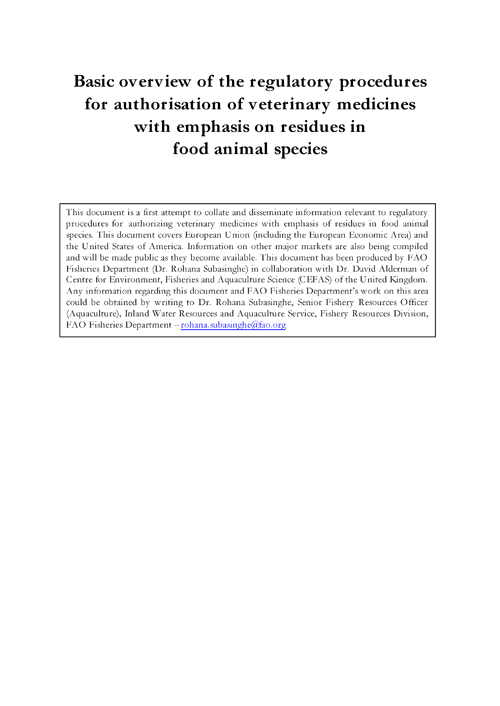Basic overview of the regulatory procedures for authorisation of veterinary medicines with emphasis on residues in food animal species
24 February 2004 | Rohana Subasinghe and David Alderman | 3318 Downloads | .pdf | 90.92 KB | Food Security, Safety and Certification, Governance and Policy, Health and Biosecurity
This report presents a précis of the regulatory procedures for authorisation of veterinary medicines in Europe and the USA. In particular it concentrates upon the requirements for consumer safety in regard to presence of residues of veterinary medicines in the edible tissues of food animal species. In both Europe and the USA the regulations in regard to veterinary residues and consumer safety are “third country” regulations requiring that countries wishing to export into those markets demonstrate that procedures are in place to ensure that the products exported meet the same standards as those enforced internally. In Europe, national animal products are monitored by Member States for presence of residues of veterinary medicines in food animal species to ensure compliance with the residues regulations. This monitoring programme and its results must be submitted to and approved by the European Commission annually and sampling normally takes place in slaughterhouses (for large animals) or at wholesale or farm level for aquaculture. Similar monitoring plan requirements are required from those countries that wish to export to the EU.
In addition to obligatory monitoring, Member States are free to monitor for all types of contamination, including veterinary medicine residues, in the retail food chain. Such retail monitoring programmes not only include products from national production, but also imports from other parts of the EU and from third countries. It is this retail level monitoring that has recently detected residues of prohibited residues in imported aquaculture products from Asia within the EU. Where monitoring of any type detects the presence of residues that are not in compliance with the current EU requirements, the foodstuff concerned is regarded as unfit for human consumption. Within the EU the Member State concerned is required to take action, if from a third country, the European Commission will take action.
This document is intended to explain the reasons for and background to the operation of veterinary medicines authorisation and residues monitoring programmes in the EU and USA. The reason that these programmes are in place is very simple. They are programmes designed to protect the safety and health of target animals, their environment and most particularly the consumers of the products from those animals. The origins are wide, from the thalidomide disaster of the 1960’s to increasing worries about misuse of antibiotics and the transfer of antibiotic resistance from animal production to humans and to the spread of drug resistant organisms such as MRSA. In Europe the regulations were introduced to provide a uniform level field within the EU (and the European Economic Area [EEA]) removing what might otherwise have impeded internal trade. However they are applied equally to food animal production within the EU and to food imported into the EU. It is therefore difficult to see how these regulations could be seen as impermissible trade barriers.
Copyright, all rights reserved.

